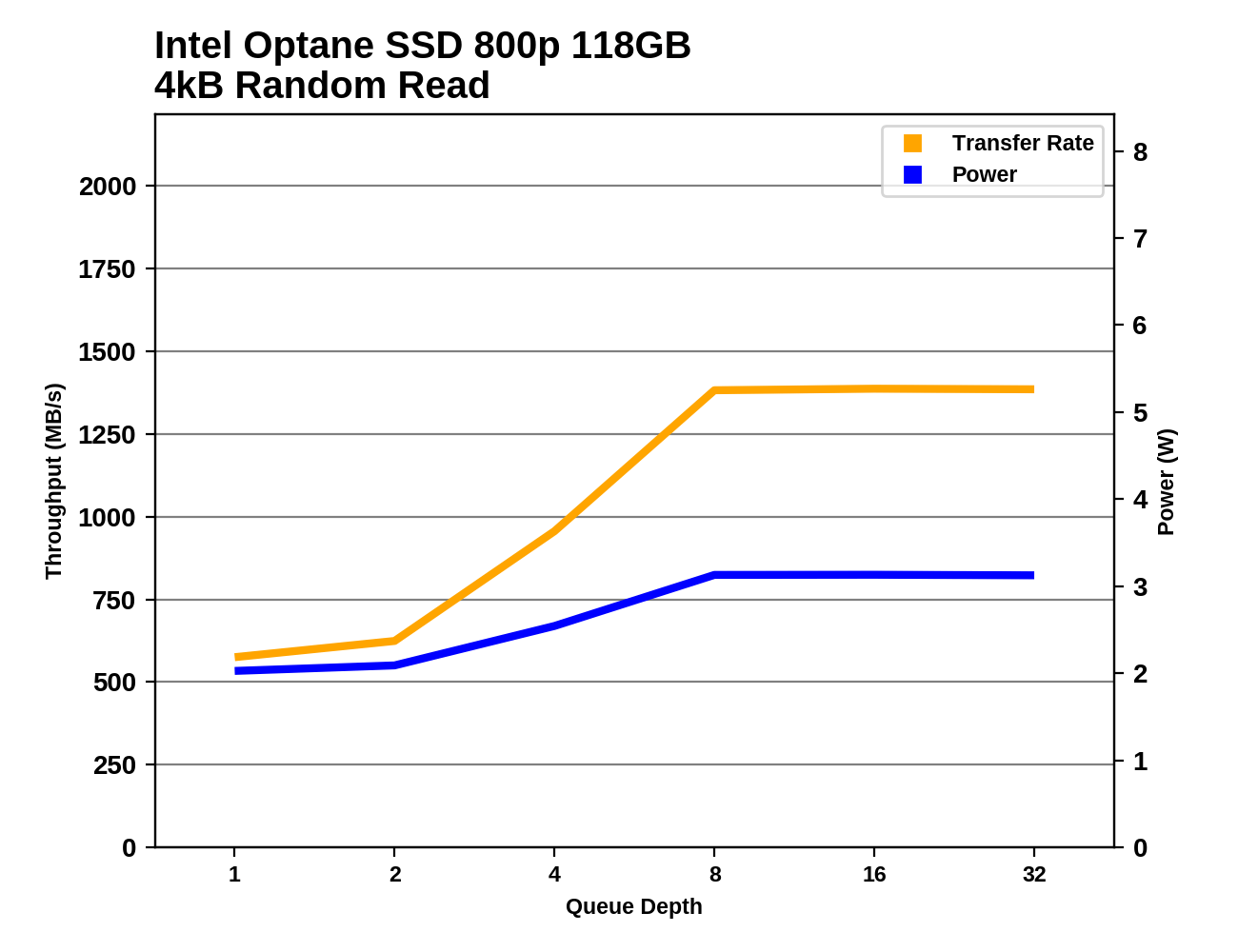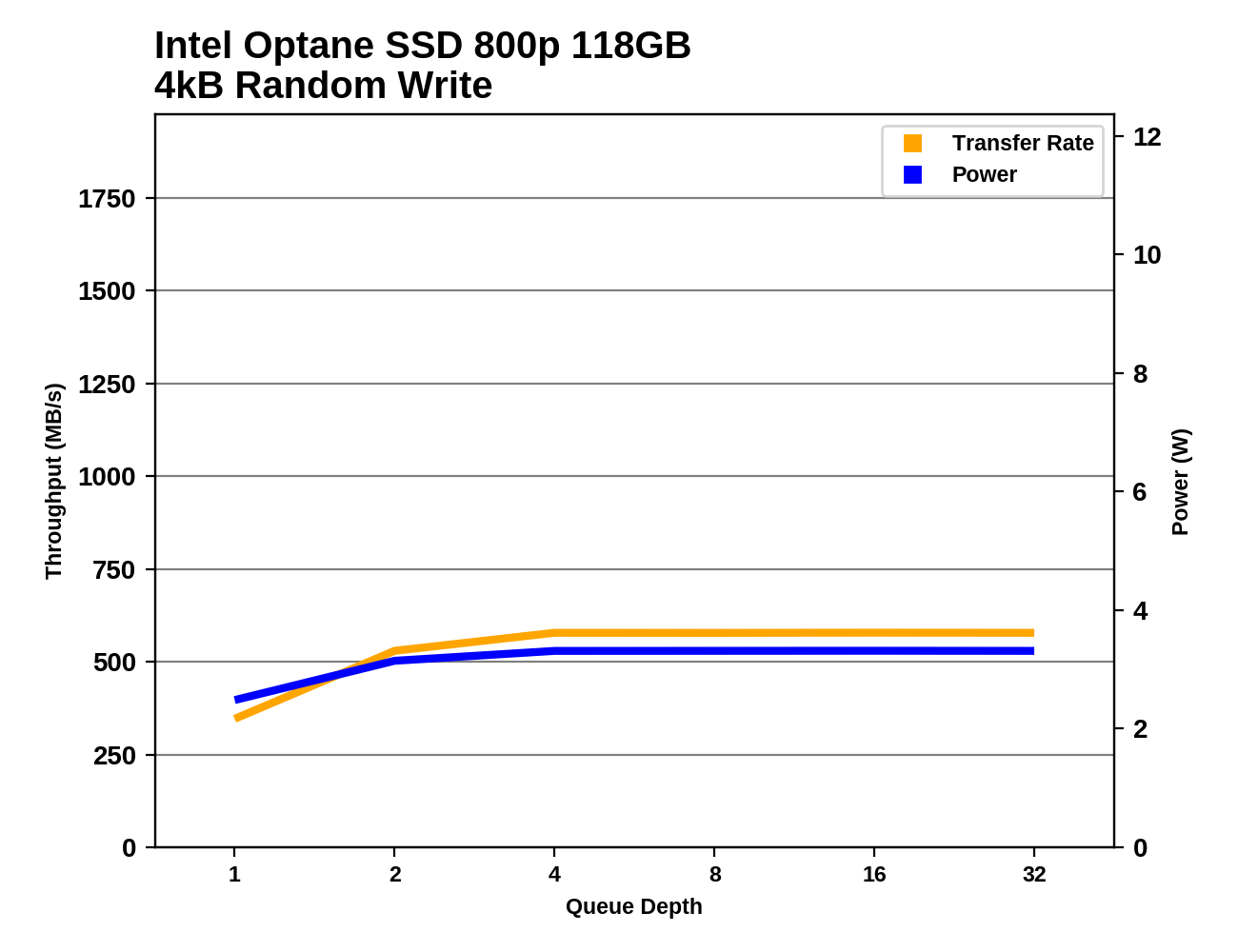The Intel Optane SSD 800p (58GB & 118GB) Review: Almost The Right Size
by Billy Tallis on March 8, 2018 5:15 PM ESTRandom Read Performance
Our first test of random read performance uses very short bursts of operations issued one at a time with no queuing. The drives are given enough idle time between bursts to yield an overall duty cycle of 20%, so thermal throttling is impossible. Each burst consists of a total of 32MB of 4kB random reads, from a 16GB span of the disk. The total data read is 1GB.

Like the Optane Memory M.2, the Optane SSD 800p has extremely high random read performance even at QD1. The M.2 drives even have a substantial lead over the much larger and more power-hungry 900p and its enterprise counterpart P4800X. Even the best flash-based SSDs are almost an order of magnitude slower.
Our sustained random read performance is similar to the random read test from our 2015 test suite: queue depths from 1 to 32 are tested, and the average performance and power efficiency across QD1, QD2 and QD4 are reported as the primary scores. Each queue depth is tested for one minute or 32GB of data transferred, whichever is shorter. After each queue depth is tested, the drive is given up to one minute to cool off so that the higher queue depths are unlikely to be affected by accumulated heat build-up. The individual read operations are again 4kB, and cover a 64GB span of the drive.

The Optane SSDs continue to dominate on the longer random read test, though the addition of higher queue depths allows the 900p to pull ahead of the 800p.

With extremely high performance but lacking the high power draw of the enterprise-class 900p, the Optane SSD 800p is by far the most power efficient at performing random reads.
 |
|||||||||
The Optane SSD 800p starts out in the lead at QD1, but its performance is overtaken by the 900p at all higher queue depths. The flash-based SSDs have power consumption that is comparable to the 800p, but even at QD32 Samsung's 960 PRO hasn't caught up to the 800p's random read performance.
Random Write Performance
Our test of random write burst performance is structured similarly to the random read burst test, but each burst is only 4MB and the total test length is 128MB. The 4kB random write operations are distributed over a 16GB span of the drive, and the operations are issued one at a time with no queuing.

Flash-based SSDs can cache and combine write operations, so they are able to offer random write performance close to that of the Optane SSDs, which do not perform any significant caching. Where the 32GB Optane Memory offered relatively poor burst random write performance, the 800p is at least as fast as the best flash-based SSDs.
As with the sustained random read test, our sustained 4kB random write test runs for up to one minute or 32GB per queue depth, covering a 64GB span of the drive and giving the drive up to 1 minute of idle time between queue depths to allow for write caches to be flushed and for the drive to cool down.

When higher queue depths come into play, the write caching ability of Samsung's high-end NVMe SSDs allows them to exceed the Optane SSD 800p's random write speed, though the 900p still holds on to the lead. The 800p's improvement over the Optane Memory is even more apparent with this longer test.

The power efficiency of the 800p during random writes is pretty good, though Samsung's top drives are better still. The Optane Memory lags behind on account of its poor performance, and the 900p ranks below that because it draws so much power in the process of delivering top performance.
 |
|||||||||
The Samsung 960 PRO and the Intel Optane SSD 900p show off at high queue depths thanks to the high channel counts of their controllers. The Optane SSD 800p doesn't have much room for performance to scale beyond QD2.










116 Comments
View All Comments
Reflex - Thursday, March 8, 2018 - link
I'm sorry you know how many are rushing out to buy a product that isn't available yet? I don't personally expect large volumes since at the current capacities it isn't in the sweet spot for consumers in price/perf, but its offering solid performance that bests NAND in almost every consumer scenario, in some cases significantly while consuming less overall power. That's a win. As production ramps, costs will come down.And only the literacy challenged have chosen to read Intel's claims about 3DXPoint's potential as claims about its first generation products. Right now its constrained by a number of things beyond the memory itself, such as PCIe bus speed.
iter - Friday, March 9, 2018 - link
And I am sorry don't possess common sense.Of course I am not talking about how the 800p sells, only a complete idiot could take this out of my comments. I am talking about the non-existent demand for it in the enterprise, which the introduction of the 800p is another testament to.
If intel was able to sell it at high enterprise margins they wouldn't be forcing it in the consumer world where it is pointless. Intel is not keep on losing money, and as overpriced as it is even as a consumer product, it is tremendously cheaper than what they can ask for it at the enterprise market. Instead they are marketing it to frigging games... which is 100% laughable.
And of course, I don't expect anyone save for silly fanboys with rich mommies to buy it in the consumer world. because it can offer absolutely nothing for the price premium it comes at. No intelligent human being would pick a 118 gb 800p to a decent 256 gb nvme or 512 gb ssd drive. None whatsoever.
Constrained by PCIe? It doesn't even come close to that. Neither in terms of bandwidth nor latency. But believe whatever it takes to reinforce your fake worldview.
Luckz - Wednesday, April 25, 2018 - link
Is there actually a point to 256 gb NVMe though? I mean, performance of the small 960 Evo sucks balls compared to the bigger ones. Why go NVMe when you can have a nice SATA drive with much more capacity and not even much worse perf?Adramtech - Saturday, March 10, 2018 - link
iter, Lehi fabs are 100% dedicated to Xpoint and no longer NAND. They wouldn't commit billions to that if they didn't have a path outlined for improvement and scaling.patrickjp93 - Saturday, March 10, 2018 - link
Are you kidding? AWS Memcached, Lambda, and DynamoDB have their caching layers and indexing stored in Optane.eddman - Saturday, March 10, 2018 - link
We just found ddriver's long lost twin brother.Alexvrb - Saturday, March 10, 2018 - link
Cloning tech gone wrong.Reflex - Saturday, March 10, 2018 - link
It's not his twin, it's just his new account. This place had a much better community during the too brief time he was gone.patrickjp93 - Saturday, March 10, 2018 - link
3DXP is being made on the 90nm node right now. What did you expect? It's a vastly cheaper research node for something so complex.And the performance is stunningly better than everything else Samsung has EXCEPT for high Queue Depth sequential performance. All real world testing shows the 960Pro getting smashed.
Reflex - Saturday, March 10, 2018 - link
Didn't you hear the memo that because this first gen product isn't as good as the theoretical max performance discussed three years ago its all a big fail? /sarcasm